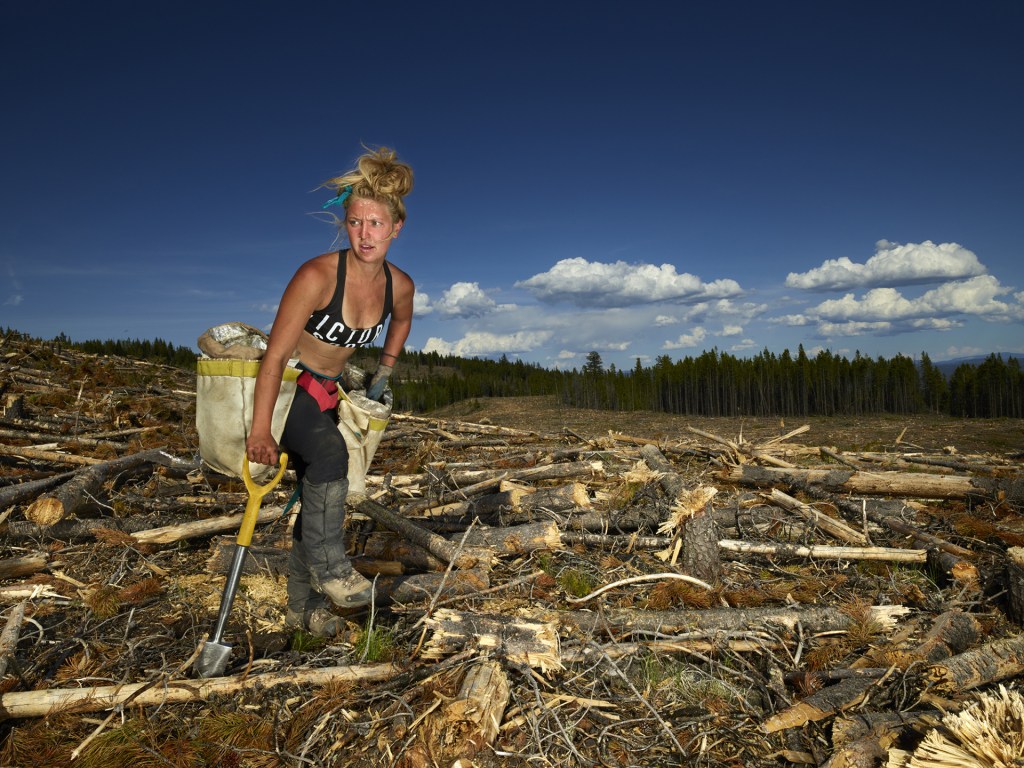Rita Leistner has been to devastating places. The Toronto-based photojournalist has been documenting conflict for decades now, embedding herself everywhere from Pol Pot’s Cambodia to Iraqi prisons. But Leistner’s latest work takes a look at something with a different brand of intensity—tree planting.
A fixture in the tree planting community herself, Leistner took her experience as a conflict photographer and applied it to young Canadian tree planters in rugged, desolate terrains documenting the physicality and intensity of this tedious work that most people aren’t even aware of. VICE spoke to Leistner about her process and life’s work.
Videos by VICE

VICE: What has the scope of your work been, have you mostly been in conflict photography?
Rita Leistner: Well, I wanted to be a conflict photographer from the age of 15 so that was the goal for a very long time. But it’s a pretty hard goal to achieve if you have no connections and don’t know how to make that happen. I mean, how the hell do you become a conflict photographer?
I couldn’t get into photography school because I didn’t really know how to do that so I ended up doing a graduate degree in literary theory which was amazing. But it seems like everything in my life, as in all of our lives, it adds up to a certain point. For me it was this goal of being a photographer.

In 1997, I got an opportunity to move to Cambodia which was a country I’d been interested in for a very long time because of its politics and history. So I moved to Cambodia and quit my job working in the film industry and hit the ground running, learnt from people there, people with much more experience than me who were incredibly generous and worked my ass off trying to get publications.

So let’s back up here, you said everything in your life culminates to where you are. So before all this you were a tree planter?
So to help put myself through university I planted trees. I started planting trees in first year, the summer after first year, that’s when I was able to get a job. My sister helped me get a job, often that’s how it works in tree planting—you know someone who does it. Especially back then, it wasn’t that well known.

Paint a picture for me, how did it happen, what year is it?
This is 1983. I basically dropped out of high school a couple credits short in 1981 and moved out west and lived in Vancouver. And then finished my degree through correspondence and then came back to Toronto and walked into the doors of Ryerson to ask if I could go into their photography program and of course they said, “Well you need to apply in advance and you need a portfolio”.

I didn’t even know that. Eventually I ended up at the doors of the University of Toronto and I got into the part time program so I was only going to be studying part time and I worked as a bike courier as well. And I was looking for a job for the next summer and my sister had planted trees so it was something I really wanted to do.

It wasn’t that easy to get a job but I went planting near Prince George, British Columbia that first year and it was terrible! I mean, it was an adventure, it was me and 11 guys but in those days we worked a 21 day shift, on our very first shift. It was an area that was remote enough that it wouldn’t have made sense to come back to town because it would have been too long of a trip, or I don’t really know why, I didn’t run the camp. But I know that we spent 21 days in the bush and that we had no running water, and it was brutal. And I just thought tree planting was the dumbest worst job on the face of the earth and I didn’t go back the next year.

However, over the course of that year I met people who said they liked tree planting and I thought either they were crazy or I missed something and I didn’t give it enough of a shot. The one thing I did like about tree planting was being somewhere remote, the clean air, working hard physically and the camaraderie. And of course, the possibility of making money in a really short time.

So I went back again and ended up staying for another eight years. So I planted for a long time, over 10 seasons. Beyond graduate school, through years of travel. I finally stopped when I took up working in the film business full time.

What does it take to be a good tree planter? It’s a tough job, it’s a gruelling job.
Yeah what continues to interest me about tree planting is people talk about the camaraderie. However, 25 years later what really sticks with me in terms of tools I’ve learnt for a living is basically the sheer perseverance that you need to be entirely alone for 8 hours, 9 hours, 10 hours, in the cutting block planting one tree after another (because you’re paid per tree so if you’re not working you’re not making any money) plus there’s nowhere to go – you get dropped off for the day.

So how did that prepare you to become a conflict photographer?
Well, when I worked in conflict zones, people would often ask me – what prepared you, what were some of things in your life that prepared you to do this work and one of the things, I said, was tree planting in Canada. Most people have no idea what that is. More Canadians do, but most Canadians don’t. Certainly if you’re in Baghdad, no one has any idea what that is.

If you’re in New York City, no one has any idea what that is. So people would say, “Well that doesn’t make any sense, that doesn’t sound all that difficult, so how could that prepare you?” At one point I was advised to take tree planting off my CV by a friend in NYC who said “it looks trivial compared to your other accomplishments”. And I thought “oh my god, people have no idea how difficult and challenging this work is.”

Compare that emotional intensity between subjects—warzone and tree planters—what’s the connection there? What’s the similarity?
We used to think that it was like working in a war zone because of the devastation of the landscape, because of how remote and dirty it was. Because we felt like warriors of the land. Of course I later went on to go to work in conflict zones and on the most important levels its’ nothing like working in conflict zones, the main thing being the security and safety. You’re never fearing for your life when you’re tree planting. But the camaraderie of living in somewhere really remote, of not having amenities, of not having running water.

These kinds of things physically prepared me for the physical difficulties of living in a conflict zone. So when I embedded with the US military in the desert in Iraq and we had no amenities and I didn’t bathe for weeks on end, it was no big deal to me because I had experienced it before. Also physically, I’ve been strong ever since I tree planted. You never really lose that, you have a real appreciation for your physical strength. And then there’s the devastation of the landscape.

Another thing is having spent a lot of time with young soldiers who are around the same age as the tree planters, and trying to think about the parallels between those two worlds, which I draw because I have so much experience in both. So when young people go to war, they do it mostly to make money. I mean yeah it’s connected to nationalism and these other things but mostly it’s a job.

Tree planting is the same. When people go tree planting they’re not thinking “oh I’m going to build a forest”, they’re not going because of environmentalist motivations. However, through that experience they change.

What was your hardest day in a conflict zone? Are there any stories [from Iraq] that you can talk about?
I love citing Dr. Anthony Feinstein, who’s a Toronto psychiatrist who has written more about post-traumatic stress disorder and war correspondence than anybody and he once told me that for journalist part of our therapy is built into the process of our work, because we’re constantly revisiting our experiences, so even if you go and you photograph a bombing, you have to go back and you have to look at your photos and you have to write about it, and you have to process it and you have to think about it.

So you know for me I’m still processing violence that I witnessed in 2003 or in 2015. I mean you’re constantly processing it, which I think is a healthy thing. Plus I have a therapist. It’s always a little bit hard to talk about but I’m also someone whose emotions are always pretty close to the surface so when I’m interviewing the tree planters for instance, I’ve known to tear up and sometimes I’ll start an interview and they’ll say “are you going to cry Rita, during my interview?” and I say “I just might.”
Rita Leister’s The Tree Planters Exhibition will take place at the Stephen Bulger Gallery 1356 Dundas Street West Toronto, ON, M6J 1Y2 CANADA
Exhibition Dates: October 21 – November 18, 2017
Reception for the Artist: Saturday, October 21, 6-9pm
More
From VICE
-

Pick up our top water flosser pick, this water flosser from Waterpik. Yeah, say that three times fast, you coward. -

Screenshot: Limited Run Games -

Collage by VICE -

(Photo by John Lamb / Getty Images)
